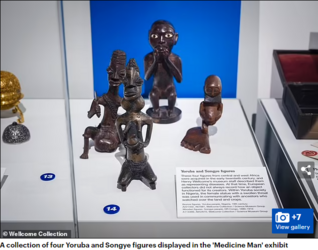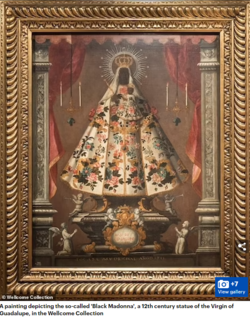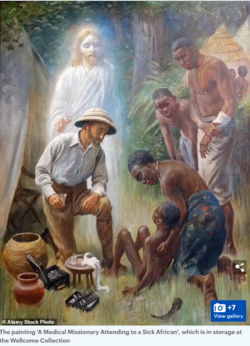Was going to use the Guardian's article but Daily Mail's has more pictures and information...

 archive.ph
archive.ph
A British museum says it is closing a free exhibit about medical history after 15 years over fears it is perpetuating 'racist, sexist and albeist theories and language'.
The Wellcome Collection, which is based in London, has been accused of 'cultural vandalism' after it said it is scrapping its 'Medicine Man' exhibit, which has been on display since 2007, from today.
The charity which runs the museum, the Wellcome Trust, said the items 'neglected to tell' the stories of those 'we have historically marginalised or excluded'.
It said it had instead been telling story of Henry Wellcome, a 19th century American pharmaceutical entrepreneur and medical artefact enthusiast who founded the collection.
It said that Wellcome, who was born in a log cabin in Wisconsin, was a man with 'enormous wealth, power and privilege' who had acquired hundreds of thousands of objects with the aim of 'better understanding of the art and science of healing throughout the ages'.
These items include wood, ivory and wax models from around the world and a variety of cultures, some of which date back to the 17th century, as well as curiosities such as Charles Darwin's walking sticks.





In a Twitter thread the museum said it had decided to close the exhibit from Sunday, November 27, adding that it had recently been asking itself 'what's the point of museums?'
'When our founder, Henry Wellcome started collecting in the 19th century, the aim then was to acquire vast numbers of objects that would enable a better understanding of the art and science of healing throughout the ages,' it said.
'This was problematic for a number of reasons. Who did these objects belong to? How were they acquired? What gave us the right to tell their stories?
'The result was a collection that told a global story of health and medicine in which disabled people, Black people, Indigenous peoples and people of colour were exoticised, marginalised and exploited – or even missed out altogether.
'We can’t change our past. But we can work towards a future where we give voice to the narratives and lived experiences of those who have been silenced, erased and ignored.'
It added that it had used 'artist interventions' to try and do this with some pieces in the exhibit, 'but the display still perpetuates a version of medical history that is based on racist, sexist and ableist theories and language'.
A Harold Copping painting of a black African kneeling in front of a white missionary was put in storage by the collection's director Melanie Keen in 2019.
The Collection's website says it 'depicts colonial hierarchies and racial stereotyping – part of history that should not be forgotten, but which could not be sufficiently countered and contextualised in the Reading Room without re-affirming those oppressions'.
The museum added that the items in the collection 'show all the extraordinary ways in which people, through time and across cultures, have sought to understand the workings of the mind and body, to protect themselves and care for one another'.
It said: 'But by exhibiting these items together – the very fact that they’ve ended up in one place – the story we told was that of a man with enormous wealth, power and privilege. And the stories we neglected to tell were those that we have historically marginalised or excluded.
'We want to change that. We want to do better. And we invite you to help us get there. Tell us: what's the point of museums?'
The decision has sparked fury online, with one angry patron calling it 'an act of cultural vandalism without even having any idea of what will take its place'.

When Henry Solomon Wellcome was born in August 1853 few could have predicted where he would end up.
The child of a missionary, Wellcome was born in a log cabin in Wisconsin and was raised by his parents as they travelled in a wagon and preached.
When he was young he took a keen interest in medicine, and at the age of 27, would set up Burroughs Wellcome & Company, a pharmaceutical firm in London.
This would later become one of the four large companies that have since merged to form GlaxoSmithKline.
Along with his colleague, Silas Burroughs, Wellcome became one of the first in England to sell medicine in the form of tablets.
After Burroughs died at the age of 48 in 1895, Wellcome took full control of the company, setting up laboratories to help with research.
He would later become a British subject and was knighted in the 1932 Birthday Honours by King George V
Wellcome, who had one child, died of pneumonia at the age of 82 in 1936, and established the Wellcome Trust in his will.
The Trust used the profits to fund charitable activities while continuing to run the pharmaceutical business, which continued to grow and developed life saving drugs for illnesses such as leukaemia.
Painting that depicts 'colonial hierarchies and racial stereotyping' locked away from public view
Among the items deemed controversial by the Welcome Collection's curators is the 1916 Harold Copping painting 'A Medical Missionary Attending to a Sick African'.
The painting shows an idealised white missionary, guided by Christ standing behind him, using western medicine to heal a sick African child.
The missionary has a medicine chest identical in type to the Tabloid medicine chests which the firm of Burroughs Wellcome made for explorers and missionaries. In the foreground is the discarded African surgical instrument, the horn (used for cupping).
The white missionary resembles Henry Morton Stanley as portrayed in a wood engraving published in the Illustrated London news.
It was previously on display, but was removed by Wellcome's director, Melanie Keen, in 2019.
On its website, the Wellcome Collection says: 'The painting was returned to storage in 2019 as part of a continuing process of reviewing what we display in Wellcome Collection, why and how.
'It depicts colonial hierarchies and racial stereotyping – part of history that should not be forgotten, but which could not be sufficiently countered and contextualised in the Reading Room without re-affirming those oppressions.'
According to the Collection's website, the item was renamed 'The Healer' in May 2022.

Fury as bosses axe museum's 'racist, sexist and ableist' medical hist…
archived 27 Nov 2022 17:14:59 UTC
- The Wellcome Collection has closed its Medicine Man medical history gallery
- It claims the exhibit perpetuates history based on 'racist, sexist and ableist' ideas
- The collection included objects from around the world dating back to the 1600s
- It has sparked fury among patrons, who have accused it of 'cultural vandalism'
A British museum says it is closing a free exhibit about medical history after 15 years over fears it is perpetuating 'racist, sexist and albeist theories and language'.
The Wellcome Collection, which is based in London, has been accused of 'cultural vandalism' after it said it is scrapping its 'Medicine Man' exhibit, which has been on display since 2007, from today.
The charity which runs the museum, the Wellcome Trust, said the items 'neglected to tell' the stories of those 'we have historically marginalised or excluded'.
It said it had instead been telling story of Henry Wellcome, a 19th century American pharmaceutical entrepreneur and medical artefact enthusiast who founded the collection.
It said that Wellcome, who was born in a log cabin in Wisconsin, was a man with 'enormous wealth, power and privilege' who had acquired hundreds of thousands of objects with the aim of 'better understanding of the art and science of healing throughout the ages'.
These items include wood, ivory and wax models from around the world and a variety of cultures, some of which date back to the 17th century, as well as curiosities such as Charles Darwin's walking sticks.





In a Twitter thread the museum said it had decided to close the exhibit from Sunday, November 27, adding that it had recently been asking itself 'what's the point of museums?'
'When our founder, Henry Wellcome started collecting in the 19th century, the aim then was to acquire vast numbers of objects that would enable a better understanding of the art and science of healing throughout the ages,' it said.
'This was problematic for a number of reasons. Who did these objects belong to? How were they acquired? What gave us the right to tell their stories?
'The result was a collection that told a global story of health and medicine in which disabled people, Black people, Indigenous peoples and people of colour were exoticised, marginalised and exploited – or even missed out altogether.
'We can’t change our past. But we can work towards a future where we give voice to the narratives and lived experiences of those who have been silenced, erased and ignored.'
It added that it had used 'artist interventions' to try and do this with some pieces in the exhibit, 'but the display still perpetuates a version of medical history that is based on racist, sexist and ableist theories and language'.
A Harold Copping painting of a black African kneeling in front of a white missionary was put in storage by the collection's director Melanie Keen in 2019.
The Collection's website says it 'depicts colonial hierarchies and racial stereotyping – part of history that should not be forgotten, but which could not be sufficiently countered and contextualised in the Reading Room without re-affirming those oppressions'.
The museum added that the items in the collection 'show all the extraordinary ways in which people, through time and across cultures, have sought to understand the workings of the mind and body, to protect themselves and care for one another'.
It said: 'But by exhibiting these items together – the very fact that they’ve ended up in one place – the story we told was that of a man with enormous wealth, power and privilege. And the stories we neglected to tell were those that we have historically marginalised or excluded.
'We want to change that. We want to do better. And we invite you to help us get there. Tell us: what's the point of museums?'
The decision has sparked fury online, with one angry patron calling it 'an act of cultural vandalism without even having any idea of what will take its place'.
Henry Wellcome - from a log cabin in the US frontier to a Knight of the realm

When Henry Solomon Wellcome was born in August 1853 few could have predicted where he would end up.
The child of a missionary, Wellcome was born in a log cabin in Wisconsin and was raised by his parents as they travelled in a wagon and preached.
When he was young he took a keen interest in medicine, and at the age of 27, would set up Burroughs Wellcome & Company, a pharmaceutical firm in London.
This would later become one of the four large companies that have since merged to form GlaxoSmithKline.
Along with his colleague, Silas Burroughs, Wellcome became one of the first in England to sell medicine in the form of tablets.
After Burroughs died at the age of 48 in 1895, Wellcome took full control of the company, setting up laboratories to help with research.
He would later become a British subject and was knighted in the 1932 Birthday Honours by King George V
Wellcome, who had one child, died of pneumonia at the age of 82 in 1936, and established the Wellcome Trust in his will.
The Trust used the profits to fund charitable activities while continuing to run the pharmaceutical business, which continued to grow and developed life saving drugs for illnesses such as leukaemia.
Painting that depicts 'colonial hierarchies and racial stereotyping' locked away from public view

Among the items deemed controversial by the Welcome Collection's curators is the 1916 Harold Copping painting 'A Medical Missionary Attending to a Sick African'.The painting shows an idealised white missionary, guided by Christ standing behind him, using western medicine to heal a sick African child.
The missionary has a medicine chest identical in type to the Tabloid medicine chests which the firm of Burroughs Wellcome made for explorers and missionaries. In the foreground is the discarded African surgical instrument, the horn (used for cupping).
The white missionary resembles Henry Morton Stanley as portrayed in a wood engraving published in the Illustrated London news.
It was previously on display, but was removed by Wellcome's director, Melanie Keen, in 2019.
On its website, the Wellcome Collection says: 'The painting was returned to storage in 2019 as part of a continuing process of reviewing what we display in Wellcome Collection, why and how.
'It depicts colonial hierarchies and racial stereotyping – part of history that should not be forgotten, but which could not be sufficiently countered and contextualised in the Reading Room without re-affirming those oppressions.'
According to the Collection's website, the item was renamed 'The Healer' in May 2022.




